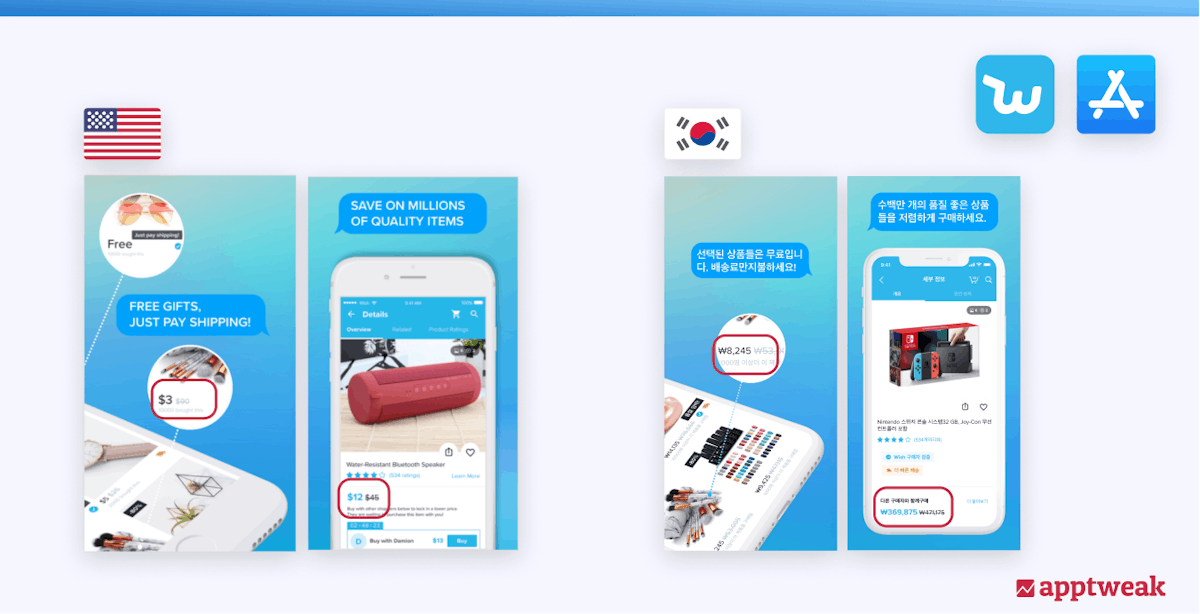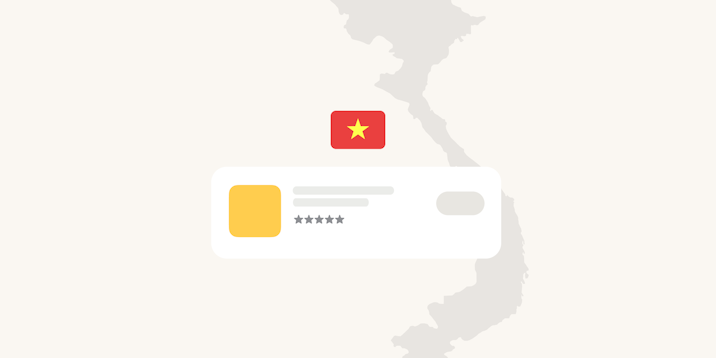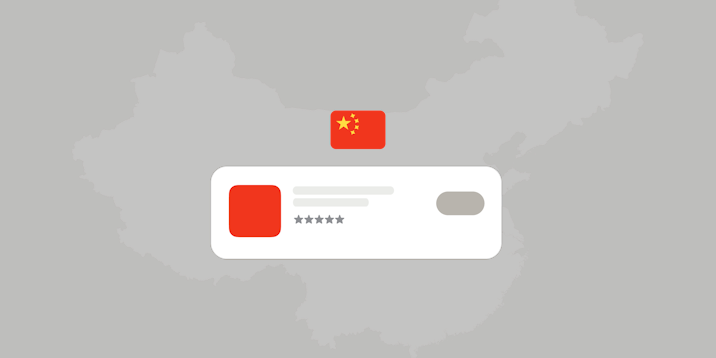
Boost App Downloads with App Store Localization
As the mobile app market continues to grow, new markets are gaining traction and more apps and games are dominating the top charts worldwide. As a result, app store localization is crucial to reach a larger number of people and compete in today’s market.
So how do you localize your app or game? Which markets are the most interesting to pursue? What should you consider when localizing your app or game for a specific market? We have gathered all the information you need to answer these questions, alongside all the tips you should know to successfully localize your app or game in any chosen market.
What is app store localization?
App store localization is the process of making your app available in several languages. However, app localization does not only consist of simple translations – you also need to work on the content itself. The process implies an in-depth understanding of the target market’s cultural norms, societal attitudes, and unique views on the content of the app or game. App store localization involves adapting your app or game to a specific country, culture, and population. This consists of four levels:
- Minimum viable translation (MVL)
- Localization and optimization of metadata
- Culturalization of creatives
- Culturalization of in-app content

Why is app store localization important?
As some major countries in the mobile app market, such as Japan or China, are generally less proficient in English, app store localization is vital to break into those markets. In fact, 8 of the top 10 markets for iOS downloads – and 9 of the top 10 markets for Google Play downloads – are non-native English markets. Moreover, although some major countries, such as France, Germany, and Italy, are highly proficient in English, most users (65%) still prefer to read content in their native language and to search the app stores using local keywords.

So, despite today’s rapid globalization, cultural and linguistic barriers remain and make app localization even more important than it ever was.
Which languages to localize your app/game into?
Although English is perceived as today’s global language, it is only spoken by 25% of the population – a figure that is continuously declining due to the rise of other world languages.
Having a localized app store presence can help you break cultural and linguistic barriers, succeed in new markets, increase conversion, and boost your app’s chances of being featured. In fact, on both the App Store and Google Play, some local editorial teams even make localization a requirement.
If you consider expanding your app or game in other countries, you will need to optimize and localize your app. As a result, you need to meet the local linguistic and cultural requirements to maximize your app’s performance and boost downloads.
Today, the App Store is available in 40 languages and the Google Play Store is available in 51 languages. This provides many opportunities to grow your app worldwide and reach a global audience. While there are a lot of languages to choose from, it is important to select the language (or set of languages) that will boost your app’s visibility and downloads on the app stores. This is because localization requires a lot of resources.
How to choose the languages most impactful for your app?
This decision will depend on your broader internationalization strategy, which should incorporate many different factors. In particular, you should consider total addressable market size, monetization capabilities, your app’s genre, and available internal resources. However, to help you make your selection, we have looked at various other factors you can consider.
Expert Tip
On both the app stores, you can set one primary locale (usually en-US or en-UK) as the default locale in case a user browses the store in a region that you did not localize for.Elements to consider before choosing languages to localize
1. Localize for languages used by your customers
The first element to consider should be your customers’ locations, or in other words, the languages that your app or game is already popular in. Your customers are the most important driver for your app’s success and they are the best indicators of how well your app will perform in a given market. Have a look at where your app is currently gaining traction despite not yet being localized. By looking at data from your app analytics, you can determine how many new or active users your app has per language and country, as well as determining from which markets your app gets the most downloads or ratings & reviews.
For instance, if your app gains a consistent and considerable number of downloads in Germany, this would suggest that localizing your app in German would attract even more users, even if German is not necessarily the most widely spoken language in the world. Knowing where your potential users are located can give you an idea of where to localize your app first. Another indicator of potentially favorable markets for your app could also include determining the markets that your competitors are localized for.
2. Localize in markets with the highest revenue market share
You can also gather some external data and consider revenue per market and market growth rate. The markets with the highest download shares do not always generate the highest revenue. Sometimes, it might be tempting to translate your app into a language just because its market is huge. However, this may not necessarily be the right approach to take. If a market is big but you feel like the population would not necessarily download and/or pay for your app, it would not be worth localizing your app into that market or language. If you are wondering which markets are the biggest in terms of revenue, below are the top markets by game revenue of 2019.
3. Which languages are worth localizing your app into?
Other than English, the most popular languages supported by the App Store are:
- German
- French
- Spanish
- Italian
- Brazilian Portuguese
- Japanese
- Korean
- Simplified Chinese
 We can see that FIGS (French, Italian, German, Spanish) remain very popular languages for app store localization and are vital to the international growth of apps and games.
We can see that FIGS (French, Italian, German, Spanish) remain very popular languages for app store localization and are vital to the international growth of apps and games.
However, their share has dropped from about 40–45% to about 35% with the rise of new languages, such as Polish, Korean, Simplified Chinese, Japanese, and Turkish. These new languages have become more and more popular as the number of gamers and local game developer studios have increased considerably.
 Thus, app store localization into FIGS languages should still be considered as a top choice today and a good place to start. This combination of languages can allow you to reach a wide range of potential users in “mature” markets where revenues and purchasing powers are high.
Thus, app store localization into FIGS languages should still be considered as a top choice today and a good place to start. This combination of languages can allow you to reach a wide range of potential users in “mature” markets where revenues and purchasing powers are high.
However, only localizing for FIGS is not enough to cover the whole app or gaming market as many large other markets are rapidly emerging. As a result, when you decide to expand into new markets, we also recommend considering the following languages:
- Simplified Chinese
- Japanese
- Brazilian Portuguese
- Russian
- Korean
- Turkish
- Polish
- Swedish
Some popular combinations for game developers in Western studios are FIGSPR (French, Italian, German, Spanish, Portuguese, and Russian). For game developers in Asian studios, popular combinations include CJK (Chinese, Japanese, and Korean).
How to create an effective app store localization strategy?
To build an effective app store localization strategy for both keyword and creative optimization, an in-depth analysis of the trends and cultural differences of the target country is required. This ensures that your visuals and text convey the intended message.
Localizing your app/game well will help it resonate with the target users, boost app downloads and drive positive reviews. On the other hand, a poorly localized app or game can have the opposite effect. As a result, thorough research is extremely important.
Research can help you produce the right app visuals that are localized to the specific country you are targeting as well as pick the most appropriate keywords for that market. This is important, as there are so many elements to consider, such as codes, color nuances, type of fonts, different spellings of a word, and tone of voice. The right visuals will make your app or game feel as though it was originally developed for the target market and thus help to make it more visible on the app stores.
It is very important to choose the most appropriate keywords for the market you are targeting. This is because a keyword can be very popular in one country but not so much in another. Also, in many languages, the same word can be expressed in different ways (formal vs informal) and even using completely different spellings. For example, in Japanese, “puzzle” can be “パズル” (formal) or “ぱずる” (informal). Knowing which version of the word to use and where is then extremely important.
How to optimize your keywords for app store localization?
A minimum-viable-translation (a simple metadata translation) is beneficial but it is only effective to a certain extent in terms of search visibility. To boost your app visibility in a new market, it is important to conduct keyword research and optimize your app for that specific locale. A “locale” is the language (represented as a lower-case two-character code) matched to a country (represented as an upper-case two-character code). We use the term “locale” rather than language to be able to differentiate dialects, such as “en-US” and “en-UK.”
1. Create a semantic dictionary in your native language
The semantic dictionary, a bulk list of keywords (about 100–200 per app/country/language), should include the most relevant terms for your app. These are terms that are directly or indirectly linked to your app’s genre and purpose. Your semantic dictionary should, therefore, include any potential search queries that would lead to your app.
You could start by building a semantic dictionary in your native language and translating it into the target language. However, you would find more relevant and high-volume keywords if you built a keyword list from scratch in the local language. This can easily be done with AppTweak’s keyword tool.
Ranked Keywords, for example, show you all the keywords that competitor apps are ranking for in the local market. The App Metadata feature, on the other hand, allows you to add any keyword that local competitors have included in their metadata. Furthermore, you can even translate your keywords into English on AppTweak to make your analysis easier.
Once you have created your initial list of single-term keywords, try to produce all word combinations possible, including broad keywords and long-tail keywords (niche keywords). One way to do this on AppTweak is to select a set of high-volume keywords that you consider relevant to your app or game and to use the Keyword Shuffler to find long-tail combinations of those keywords.

2. Use AppTweak’s key performance indicators
Once you have built your semantic dictionary, it is time to start looking at data using AppTweak’s keyword intelligence tools. This step is highly important, as it will help you clean up your semantic dictionary and make your final keyword selection.
Relevancy
The first element to consider when selecting keywords for your metadata is relevancy.
Target keywords related to your app’s functionality and/or to your gameplay. This way, your app or game will rank higher for relevant keywords instead of generic keywords, as both the app stores want to show apps and games that match the users’ search intent. One way to make sure that a keyword is relevant to your app is to use AppTweak’s live search feature to better understand which kind of apps target this keyword and which apps currently appear at the top of search results for this term.
Once you have removed all the irrelevant keywords, you can use AppTweak’s keyword metrics to help you decide which keywords are worth targeting for your app or game:
Volume (Search Popularity)
This indicates how often a keyword is searched in the app stores. The volume varies between 5 and 100. The closer the figure is to 100, the more popular the keyword is in terms of searches.
Chance and Difficulty scores
These metrics indicate how hard it would be for your app or game to rank on a specific keyword. The higher the chance and the lower the difficulty, the more possible it is for your app or game to rank on that keyword.
KEI (Keyword Efficiency Index)
Generated by AppTweak, KEI indicates the visibility potential of a keyword. It takes into account the keyword’s volume and chance score. The higher the KEI, the more potential that keyword has to increase your app’s visibility.
Combinations Table
In the Combinations Table, we aggregate your keyword list so all the long-tail keywords appear under their main combination. You’ll be able to identify which keywords are good opportunities but also monitor more precisely which keywords have the biggest impact when they’re added to your metadata.
.png?auto=format,compress&q=75&w=1200)
Once your final list of relevant single-term keywords to target is selected, start thinking of suggestions for your app or game’s metadata (title, subtitle, short description, keyword field, etc).
3. Hire a native speaker
To make sure your message is properly conveyed, we recommended having your metadata suggestions reviewed by a native speaker. The translator should preferably originate from the country you are targeting because a direct translation is not enough. Ask them to review your metadata suggestions and give you a few additional variations for each suggestion based on the keywords you have selected. Some sentence structures make more sense and have better search volumes than others in that language. As a result, hiring a native speaker becomes even more important to correctly convey your message.
To get the most out of your translator, it is not enough to provide them with your selection of keywords and metadata suggestions. It is also important to provide the translator with all the necessary information about your app or game. The more information you provide, the greater understanding the translator will have of your app. This, in turn, will increase the quality of your localized metadata and allow your localized app to further resonate with your target users.
4. Monitor, iterate, update, repeat
When you have launched your new app update with your localized keywords, wait about 4 to 6 weeks and then track the results.

We advise you to iterate this process regularly if you want to maximize your results.
Both the App Store and Google Play are fast-evolving ecosystems where trends and rankings change constantly.
It is crucial to regularly update your app to stay up to date with the latest algorithm changes and effectively outrank your competitors.
Discover AppTweak’s keyword monitoring features to closely monitor your app’s performance
How to optimize your creatives for app store localization?
Localization does not only consist of keyword optimization. It also involves working on your app’s content itself – creatives and in-app content. This is called culturalization. The first step of this process consists of creating a custom app store page for a different locale based on that market’s unique beliefs, views, and values. Here are some basic elements to keep in mind when localizing your app store page:
- Avoid offensive topics and language. A topic that might be acceptable in one culture could be offensive in another.
- Use the correct references and formats in your graphics and text. Some very important elements to keep in mind are units of measurement (e.g. miles vs. kilometers), currencies (e.g. commas vs. periods for prices – in Europe, they write $2,99 instead of $2.99), and dates (MM/DD/YYYY in the US vs. DD/MM/YYYY in Europe).

- When adding captions to screenshots, use a font that provides full support for the target language and not one that doesn’t support the whole alphabet or all the characters (especially for non-Latin languages).
- Use local locations/places and models in the screenshots to make the app feel like it was made for local users.
.png?auto=format,compress&q=75&w=1200)
- Use locally understood cultural references. Some colors and numbers have positive connotations in some countries, whereas in others they may have negative ones. For example, in China, the color red is associated with luck and prosperity and is used by many apps.
- Optimize your listing to highlight the features that resonate most with local users (including the order of screenshots). Users in different markets tend to have a preference for a certain feature of your app over others.
Localizing your app for Asian markets
As mentioned earlier, when looking to expand into a new market, research is extremely important to successfully localize and culturalize your app or game. Some elements to consider when researching include a country’s mobile landscape, language, metadata and creative best practices, as well as any other trends specific to that market.
We have researched three of the largest Asian markets in the mobile app industry – Japan, Korea, and China. These markets have unique audiences, cultures, and mobile landscapes that make them very challenging to break into.
As a result, research is even more important to allow your app or game to succeed in these countries. Here are some interesting elements to consider when localizing your app for these markets.
Best practices to localize your app for Japan
Japan has become one of the largest markets in terms of mobile revenue, making Japan the go-to market for apps and games that are looking to expand worldwide.
Mobile landscape
Even though some popular local smartphone vendors, such as DoCoMo that run Google’s Android mobile operating system are predominant in Japan, the Japanese mobile market is dominated by iOS (68.3% of total users according to DeviceAtlas). Still, Android represents quite a significant portion of Japanese users, so it remains preferable to make your app or game available for both Android and iOS in Japan.
Language
Japanese is a very concise language. Its grammar does not require spaces between characters, and words consist of sometimes only one or two characters. This means that for the same amount of characters, you can fit in more Japanese words than you could for English words.
Also, the Japanese language has three distinct alphabets that are used in daily life: Kanji, Hiragana, and Katakana. The Hiragana version of a keyword is often the most popular and the most used for search queries in the stores. Nonetheless, it is always recommended to check which version of a word is the most popular before making a final decision.
Metadata
Regarding titles and subtitles for Japanese apps, the first thing to remember is to put a space between each keyword as in English. This helps in keyword indexation and lowers the risk of rejection due to keyword stuffing. For example, the title “キッズ無料ゲーム,” which means “kids free games,” has a high risk of rejection since it appears to just add keywords instead of forming a logical statement. It would be better to write “キッズ向けの無料ゲーム,” meaning “free games for kids.”
For the keyword field, as in English, it is important to separate each keyword by a comma to maximize exposure. For example, the keywords “video editing” would have no space in Japanese (“動画編集”), unlike in English. Still, it would be best to separate the two words by a comma in the keyword field like this “動画,編集”.
As for the keywords to include in the title and subtitle, it is recommended to use relevant keywords written formally, regardless of search popularity. In a few cases, depending on your target audience and how you want your brand to be perceived, you can use everyday words that the user is more likely to search for. For instance, it would be better to use the Japanese version of the English word “chat” (チャット) rather than “communication” (コミュニケーション).
Creatives
The Japanese market is extremely different when it comes to ASO trends, design/creative trends, and games. Japanese people have strong interests in anime and manga. As a result, in Japan, it is important to consider 3 important elements: game, manga, and anime. Another important element is kawaii, meaning “cuteness,” which also plays a big role in Japanese culture and makes cute mascots or visual elements very appealing. Here are some other general tips to successfully culturalize your creative assets for the Japanese market:
- Character focus: Japanese customers like attention-grabbing images of people or characters. Having as many characters as possible on creatives, and visually highlighting them (often placed in the foreground), would make the creative more appealing to Japanese users.
- Fonts and texts: More text content and information is included on creatives in Japan. The text is also bolder, more aggressive, and more colorful (e.g. contour lines) than in the West.
- Crowded/highly dense creatives: Creatives in Japan are more crowded than in the West – almost no space is left unfilled, whether that be on icons or screenshots. This can be done by using lots of small elements, adding special effects or particle systems, and incorporating emotional stimuli all over the images.
- Bright and vivid colors: Mixing colors and textures is an important part of Japanese culture. Colors should be bright and positive (RGB color scheme) to make visuals pop.
Gain more interesting insights into the best practices of app localization in Japan
.png?auto=format,compress&q=75&w=1200)
Best practices to localize your app for China
China has become the world’s biggest app market and expects to see year-over-year growth of 6% each year. This means that localizing your app or game in Chinese should be a high priority.
Mobile landscape
The Chinese mobile market is very different from any other market. While the App Store is present and operational in China, Google Play is blocked, making it more difficult for apps and games to reach Android users. Despite this, the number of Android users (77.61% of total market share) is much greater than iOS (21.93% of total market share) as over 200 local alternative Android app stores are available for Chinese users.
Language
Chinese is a very concise language that generally does not require much space. Therefore, words in Chinese consist of much fewer characters than in English (and require 30% less space). Still, Chinese characters are very complex so it is recommended to use a larger text font in your in-app/game text.
Furthermore, there are two different types of Chinese languages available to choose from on both app stores: Simplified Chinese (zh-CN) and Traditional Chinese Taiwan (zh-TW). Whether to use one or the other depends on the region you want to target as the language spoken differs from one region to another. However, we would recommend defaulting your app or game to Simplified Chinese, as this is preferred by most users in mainland China.
Metadata
- Translate your app title when entering the Chinese mobile app market. For games in particular, rename your game and keep the title under 5 Chinese characters. This makes the title easier to pronounce and remember which can then positively impact app downloads. Also, keep in mind that you don’t have to add spaces between Chinese characters for your title or subtitle.
- For the long description, use bullet lists rather than long paragraphs to make it less time-consuming. Chinese users usually do not want to read long texts and would rather watch your app’s video, screenshots, and/or gameplay. Also consider highlighting social proof (if you have any) in the long description for your app, as this is an effective way to convert customers in China.
Creatives
The Chinese market is quite demanding regarding ASO trends, design/creative trends, and games.
Chinese customers tend to prefer bright and busy creatives rather than minimalistic designs as in the West. The Chinese also make sure that their app creatives and text/keywords are aligned with their cultural elements and beliefs. Here are some best practices to successfully culturalize your creative assets for the Chinese market:
- Bright and colorful images: Increasing saturation and removing dark colors (brown, grey, etc), especially for games, makes visuals pop and appeal more to Chinese users.
- Busy creatives: Creatives are covered or filled with many small elements, particle systems, and special effects so that no space is left unfilled or blank. Chinese customers tend to prefer complex and crowded creatives.
- Detailed visuals: Have your visuals include easy-to-understand text/subtitles and links that show users all the relevant features and functions (5 or 6 screenshots). For example, adding customized text boxes to each screenshot can positively impact conversion.
Learn about additional tips to localize your app in China
Best practices to localize your app for South Korea
South Korea has become one of the world’s biggest app markets, and expects to see year-over-year growth of 11% each year. This means that localizing your app or game in Korea is a must to succeed in this market.
Mobile landscape
Contrary to Western markets, Android (68.62% of total users) dominates the South Korean mobile market. .
Android app stores other than Google Play stand out, with the One Store being particularly prominent.
Still, iOS represents quite a significant portion of Korean users (31.04%). So make your app or game available for both Android and iOS in South Korea.
Language
The Korean alphabet in South Korea is called Hangul.
As in Latin languages, it is written from left to right. One Hangul character generally takes the equivalent space of two English characters.
So, in cases where the translation doesn’t fit, it might not always work to adjust the font size. It can make the words difficult to read.
Also, Hangul has a very unique grammatical structure, including a lot of different tones and nuances. This makes it challenging and more prone to low-quality or wrong translations.
So, work with a native speaker to select the best tone, word order, font, etc.
Metadata
- Translate your app title when you enter the South Korean market. In fact, 75% of the top 25 apps and games on both the App Store and Google Play in Korea have their title either solely in Korean or in both Korean and English, separated either by a dash, a space, or with the other version in parentheses. That’s because most users want to see their apps and games in Korean due to the market’s moderate proficiency in English.
- Popular international brands (e.g. Instagram, Netflix, Minecraft, Pokemon GO, etc) could choose to keep their app title in English. However, the subtitle and long description need to be localized in Korean because Korean customers typically prefer apps and games in their own language. But since Koreans are moderately proficient in English, some words such as “ok” and “cool” are fine to be kept in English. Other words, such as “game” or “puzzle,” also drive a considerable amount of traffic. Therefore, it may still be worth adding such terms to the keyword field for iOS.
Creatives
When it comes to creative assets, the Korean market is extremely different from the West. Korean customers tend to prefer complex designs than minimalistic and realistic designs found in the West.
An important element for this audience is aegyo, the use of cute and babyish voices and facial expressions especially to get your way. Add anime elements and cute characters/storylines to games.
Also consider including Asian models to your app screenshots to make them more appealing to Korean users.
Here are some other general tips to successfully culturalize your creative assets for a South Korean market:
- Character-focused graphics: Korean customers tend to like high-quality in-game graphics and are drawn by images that display a large number of characters. Emphasize the characters to make creatives more appealing to South Korean users.
- Colors: Color connotations are very important in Korea. Some colors, such as white, green/blue, and yellow, have positive connotations, whereas others, like black and red, have negative ones. So, select the right colors for your creatives.
- Leveling systems: Koreans generally like games that have deep leveling systems usually found in role-playing games (RPG). Try to show the multiple levels of your game in screenshots and the preview video to positively impact conversion.
Localize your app successfully in South Korea with these best practices
Conclusion
To conclude, app store localization is a complex process that requires different steps and varied approaches. Each geographical market is unique regarding its mobile landscape, language, cultural norms, ASO trends, visual preferences, colors, and more. However, localizing your app or game – and its app store presence – is crucial when launching your app in new markets. Understanding the market you want to enter and culturalizing your app or game accordingly are the keys to successful localization.



 Ian Pernia
Ian Pernia
 Justin Duckers
Justin Duckers


